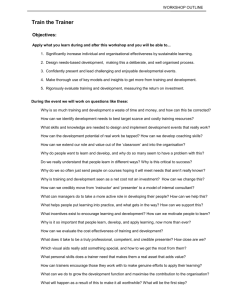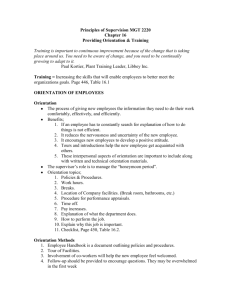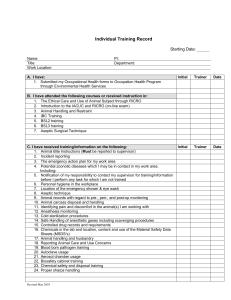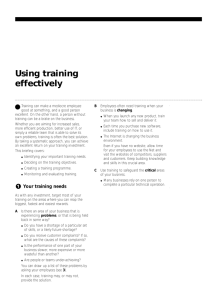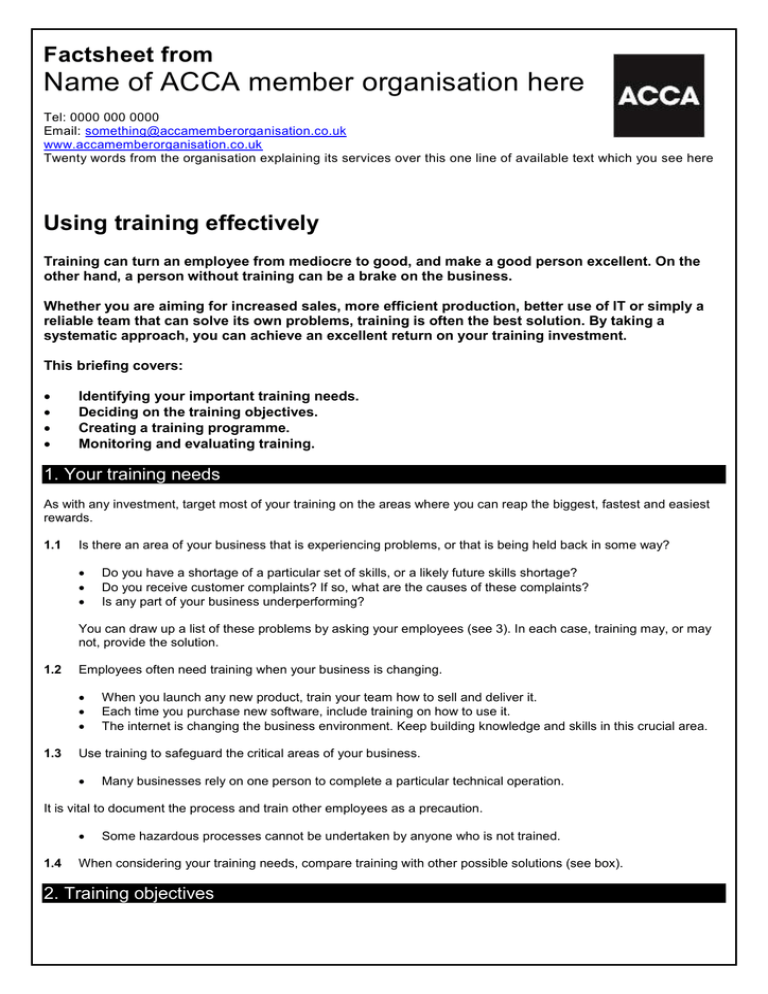
Factsheet from
Name of ACCA member organisation here
Tel: 0000 000 0000
Email: something@accamemberorganisation.co.uk
www.accamemberorganisation.co.uk
Twenty words from the organisation explaining its services over this one line of available text which you see here
Using training effectively
Training can turn an employee from mediocre to good, and make a good person excellent. On the
other hand, a person without training can be a brake on the business.
Whether you are aiming for increased sales, more efficient production, better use of IT or simply a
reliable team that can solve its own problems, training is often the best solution. By taking a
systematic approach, you can achieve an excellent return on your training investment.
This briefing covers:
Identifying your important training needs.
Deciding on the training objectives.
Creating a training programme.
Monitoring and evaluating training.
1. Your training needs
As with any investment, target most of your training on the areas where you can reap the biggest, fastest and easiest
rewards.
1.1
Is there an area of your business that is experiencing problems, or that is being held back in some way?
Do you have a shortage of a particular set of skills, or a likely future skills shortage?
Do you receive customer complaints? If so, what are the causes of these complaints?
Is any part of your business underperforming?
You can draw up a list of these problems by asking your employees (see 3). In each case, training may, or may
not, provide the solution.
1.2
Employees often need training when your business is changing.
1.3
When you launch any new product, train your team how to sell and deliver it.
Each time you purchase new software, include training on how to use it.
The internet is changing the business environment. Keep building knowledge and skills in this crucial area.
Use training to safeguard the critical areas of your business.
Many businesses rely on one person to complete a particular technical operation.
It is vital to document the process and train other employees as a precaution.
1.4
Some hazardous processes cannot be undertaken by anyone who is not trained.
When considering your training needs, compare training with other possible solutions (see box).
2. Training objectives
2.1
To keep training relevant and focused, set SMART (specific, measurable, agreed, realistic and time-limited)
objectives.
2.2
Often, the objective will be to reach a specified standard for the performance of a particular task.
2.3
For example, doing a time-management course ‘with the objective of clearing your in-tray by the end of every
day’ will focus you, during and after the course.
Set the standard by assessing how well an experienced person completes the task.
Try breaking the standard down into three required components: knowledge, skills and attitude.
Set out the conditions under which the standard is to be achieved.
When a new task is introduced, the desired performance standard may be less clear.
Keep training objectives in line with business objectives.
For example, if you are setting up an online shop, train staff how to use the software so they can maintain
the website.
3. Commitment of employees
Successful training depends on getting your employees involved.
3.1
Win your employees’ support for the training, by explaining the need for it and the objectives you plan to achieve.
3.2
Ask employees what training they think would improve their productivity.
3.3
Explain the benefits for the employee as well as the business. Be enthusiastic.
Initially, train those who are keen. Then let them demonstrate the benefits of the training to the doubters.
If an employee asks for training, ask him or her to describe the benefits it will have for your business.
Find out how each employee prefers to learn.
Some people may enjoy group learning, while others prefer individual study.
Some people prefer steady progress through a training process.
Others are keen to get hands-on experience as soon as possible.
3.4
Explain the different training options you are considering. Let people know their training preferences will be
acknowledged.
Personal development plans are a systematic method of identifying training needs and agreeing the best way
forward.
4. The training plan
A training plan is essential to define the structure and outcomes you want from training.
4.1
Draw up a training brief, setting out your practical training objectives.
For example, you might list ten tasks and ten awkward situations a new credit controller should be able to
handle.
Without this approach, there is a danger of the employee learning the theory, with no practical understanding of how to
apply it.
Draw up an achievable training brief with the trainer.
2
4.2
For each course, have a written training programme identifying the stages of the programme, the location, the
content and methods used, and the name of the trainer.
Sign and date items as the employee progresses through the training. A copy of this record can then be
added to the employee’s personnel file.
Documentation is essential for most formal qualifications, such as NVQs, and to satisfy health and safety
requirements.
Note the cost of each element, so you can evaluate which stages are worthwhile.
‘Off-the-shelf’ training courses address many of these issues automatically. Many are designed to achieve, or
count towards, a particular recognised qualification.
List all the training activities for the year in your training plan. Confirm that the budgets, resources and timing are
all viable.
5. In-house training
All businesses automatically carry out in-house training when a new employee arrives, sometimes without realising it.
The challenge is to get everyone’s performance up to standard, as quickly and cheaply as possible, with minimal
disruption.
5.1
Most in-house training takes the form of on-the-job training.
This lets people learn at their own pace and apply new knowledge immediately.
5.2
Job shadowing involves one person showing another all the aspects of a job.
5.3
This is especially suitable for new employees, as part of their induction. Shadowing is a painless way to
cover a lot of ground in a short space of time.
Once a person can do the job, continue coaching the employee.
5.4
Take care when deciding who will provide the training.
The trainer must be technically able to do the task. Provide relevant training for trainers, including how to set
goals, how to break information down into small steps, and how to progress at the pace of the trainee.
If the trainer has bad work practice or a bad attitude, these will be passed on.
Periodically review progress. You can give feedback and guidance on how further improvements can be
made.
Consider finding a mentor, especially for senior employees whose performance has a major impact on the
business.
Mentoring is usually carried out by someone outside the immediate team, or even by someone from outside the
company.
Mentoring can be extremely effective in helping to unleash the potential of your more dynamic (or difficult)
employees.
People can open up to an outsider in ways that are impossible with a line manager — not least because the line
manager can be the biggest obstacle to progress.
A good mentor is a good listener, with the experience to suggest practical solutions. He or she should also
set an example and challenge the trainee’s ideas.
6. External training courses
6.1
The main advantage of using external trainers is that they are specialists.
3
6.2
Training comes in a wide range of forms.
6.3
It is a powerful and cost-effective way of introducing new ideas and approaches. It can also be used to
monitor progress and assess learning.
It is especially useful when you need to train a large number of staff across different locations (eg to
demonstrate compliance with health and safety regulations).
Trainees progress at their individual pace.
The course can be completed at home or in the workplace.
There are a wide range of courses available. Interactive courses are also available to support behavioural
training.
External training can bring fresh ideas and energy into the learning process.
6.5
Lectures and conferences typically thrust a mass of information at a large audience.
Seminars help people acquire knowledge in a more interactive way.
Workshops give people information and let them practise working out problems.
Distance learning may make use of workbooks or DVDs, while e-learning is computer-based.
E-learning offers a number of key business benefits.
6.4
The trainer may have spent years refining a course.
The trainer can bring you up to date with current best practice.
Mixing with trainees from other businesses can be an opportunity to discover how these other businesses do
things.
A good trainer may challenge the way your business currently operates.
Check with your local business support organisation about relevant training courses.
7. Did it work?
You know your training has worked if it delivers the objectives outlined in your training brief.
7.1
Review the impact of the training on performance, as part of a regular appraisal process.
7.2
Any additional training needs can be discussed at this point.
Evaluate training by asking your employees to review their training experience.
Was the training relevant to the job and appropriate to their level of expertise?
7.3
When employees complete any training, discuss how their learning will be put into action.
Training assessment forms may help you discover more about the course and establish what worked and
what did not. But be aware that what the trainee sees as a ‘positive’ training experience is not necessarily
valuable to your business.
Monitor improvements in the performance of the business.
Measurable performance indicators include sales, production costs, output, attendance levels and staff
turnover.
Qualitative improvements may include higher quality goods or services, better teamwork, more satisfied
customers and more innovation in your business.
Has the training added value to your business?
Buying training
A.
Choose a provider that addresses your needs, rather than trying to sell you a standard training solution.
4
B.
Establish who will deliver the training and what experience he or she has.
C.
Often the person selling the training is far more impressive than the trainer who turns up on the day.
Look beyond the training activity itself and agree what support is needed.
D.
Business support organisations are a good starting point. As well as courses of their own, they can direct you
to a range of alternatives.
For example, training on a new database might be in three stages: agreeing objectives, completing the main
training, and follow-up support to help people achieve agreed action plans.
Compare the expected benefits of the training with the total costs involved.
Allow for the direct costs as well as the set up time and the work time of those attending.
Consider the wider benefits.
Ask external training providers to quote for 100 per cent of costs, even if an exact estimate is not possible.
Ask what additional expenses will be charged for — such as phone calls and travel.
Consider how to reduce training costs.
The benefits of training will be lost if employees return to a workplace where they cannot use what they have
learned.
When training isn’t the answer
Training is not the answer for every business problem. Before investing in training solutions, analyse what is really
needed.
A.
If an employee is underperforming, they may be the wrong person for the job. The answer may be a switch to
another role, or, in extreme cases, dismissal.
B.
The problem may be caused by inadequate systems and policies.
For example, a jammed switchboard may be caused by a high volume of calls and inadequate equipment. The answer
may be to add another receptionist, or to upgrade the technology.
C.
Basic training can often be achieved by putting together a resource base.
This explains where to find things (eg key documents), how to complete basic tasks, office procedures and
other basics.
People can then train themselves, updating each entry as necessary, so the resource base remains up to date.
Experts’ quotes
“The question is not just how much your training will cost, but how much it will cost if you don’t train.”
Peter Neall,
Neall Scott Partnership training consultants
“If you work as a team, train as a team. One person attempting to carry out ‘best practice’ in isolation is doomed to
failure.”
Toby Peyton-Jones,
Siemens
Expert contributors
Thanks to Margaret Dale (management consultant, 01484 682 710); Toby Peyton-Jones (Siemens,
www.siemens.com).
5
Last reviewed 01.02.12
© BHP Information Solutions 2012. ISSN 1369-1996. All rights reserved. No part of this publication may be reproduced or transmitted without the
written permission of the publisher. This publication is for general guidance only. The publisher, expert contributors and distributor disclaim all liability
for any errors or omissions. Consult your local business support organisation or your professional adviser for help and advice.
6

